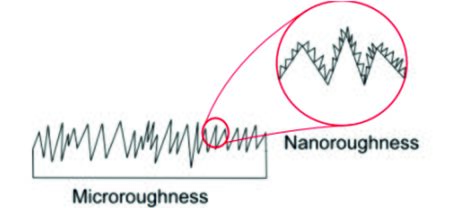Microroughness and nanoroughness
Jump to navigation
Jump to search

The roughness of an superhydrophobic (water repelling) surface contains two types of roughnesses; microroughness and nanoroughness. Microroughness forms the overall topography of the surface and nanoroughness is located on the top of microroughness.
Mechanical destruction of the surface roughness will diminish the superhydrophobicity of the surface, which can increase the ice adhesion considerably.
More on this topic:
References
- ↑ Properties of icephobic surfaces in different icing conditions. Stenroos Christian. Master of Science Thesis. TAMPERE UNIVERSITY OF TECHNOLOGY. October 2015. Online.
- ↑ S. Farhadi, M. Farzaneh, S. A. Kulinich, Anti-icing performance of superhydrophobic surfaces, Applied Surface Science, vol. 257, no. 14, 2011, pp. 6264–6269.
- ↑ S. a Kulinich, S. Farhadi, K. Nose, X. W. Du, Superhydrophobic surfaces: are they really ice-repellent?, Langmuir : the ACS journal of surfaces and colloids, Vol. 27, No. 1, 2011, pp. 25–29.
- ↑ J. Chen, J. Liu, M. He, K. Li, D. Cui, Q. Zhang, X. Zeng, Y. Zhang, J. Wang, Y. Song, Superhydrophobic surfaces cannot reduce ice adhesion, Applied Physics Letters, Vol. 101, No. 11, 2012, p. 111603-1-11603-3.